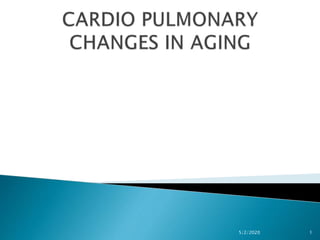
Age related changes Cardiopulmonary system.pptx
- 1. 5/2/2020 1
- 2. 1. Age-Related Cardiovascular Changes a. Anatomical Changes b. Physiological Changes 2. Age-Related Changes in the Respiratory System 5/2/2020 2
- 3. Anatomical Changes 1) Increase in fatty tissues in the outermost layer of the heart muscle. 2) Increase in the thickness of the left ventricular wall. 3) Reduction in the amount of elastin in the arterial walls and myocardium and an increase in collagen deposition. These changes causes increased stiffness. 4) Accumulation of lipofuscin, a pigment giving a brown appearance to heart myocardium. 5/2/2020 3
- 4. 5) Decreased efficiency in contractile strength of the heart muscle. 6) Thickening and sclerosis of the valve flaps of the heart, especially the tricuspid and mitral. 7) Significantly decreased number of pacemaker cells with a concomitant decrease in the S-A node rate. 8) Calcified, less elastic coronary arteries. 5/2/2020 4
- 5. Physiological Changes 1) Cardiac output declines with age. 2) Slight arrhythmias. At rest, heart rate in people of older age is essentially the same as in younger people. However, some evidence suggests arrhythmias become more common with age. 3) Longer recovery. Older heart muscle requires a longer time to recover after each heartbeat. 4) Blood Pressure increases as arterial resistance is increased. 5/2/2020 5
- 6. 1) Calcification of the laryngeal and tracheal cartilage occurs. Glandular cells in the large airway are reduced, resulting in decreased production of protective mucus. The cough reflex is blunted, causing decreased effective coughing. 2) With age, the number of functional alveoli decreases. Overall, there is a decrease in the surface area available for oxygen–carbon dioxide exchange. 3) Presbylaryngis refers to aging changes in voice pitch caused by thinning or aging of the vocal cords. 5/2/2020 6
- 7. 4) Skeletal changes such as calcification of the costal cartilages and weakened respiratory muscles all affect respiratory functioning. 5) The lungs decrease in size and weight. They have less elastic recoil. This results in an increase in residual Volume. 6) The muscles responsible for inhalation and exhalation lose strength and endurance as a part of the aging process, and there is increased stiffness of the chest wall. 5/2/2020 7
- 8. Physical Change & Aging(6th edition) Essential Geriatrics: Henry Woodford (2nd edition) 5/2/2020 8
- 9. 5/2/2020 9